高一英语必修三unit5Canada
- 格式:ppt
- 大小:5.48 MB
- 文档页数:37

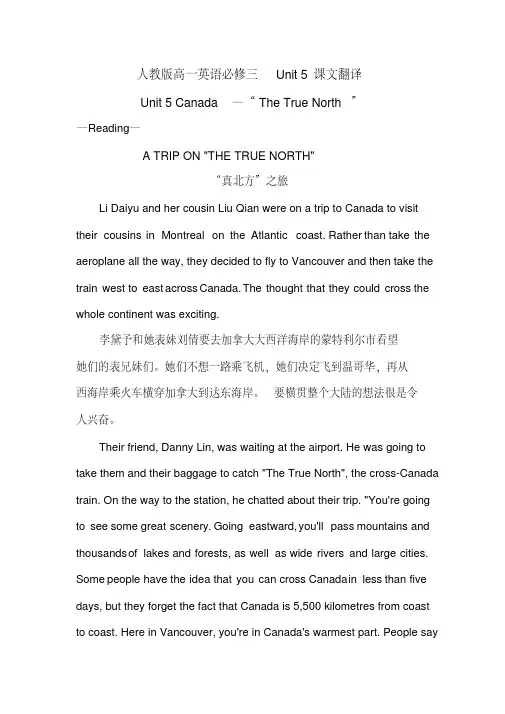
人教版高一英语必修三Unit 5课文翻译Unit 5 Canada —“The True North”—Reading—A TRIP ON "THE TRUE NORTH"“真北方”之旅Li Daiyu and her cousin Liu Qian were on a trip to Canada to visit their cousins in Montreal on the Atlantic coast. Rather than take the aeroplane all the way, they decided to fly to Vancouver and then take the train west to east across Canada. The thought that they could cross the whole continent was exciting.李黛予和她表妹刘倩要去加拿大大西洋海岸的蒙特利尔市看望她们的表兄妹们。
她们不想一路乘飞机,她们决定飞到温哥华,再从西海岸乘火车横穿加拿大到达东海岸。
要横贯整个大陆的想法很是令人兴奋。
Their friend, Danny Lin, was waiting at the airport. He was going to take them and their baggage to catch "The True North", the cross-Canada train. On the way to the station, he chatted about their trip. "You're going to see some great scenery. Going eastward, you'll pass mountains and thousands of lakes and forests, as well as wide rivers and large cities. Some people have the idea that you can cross Canada i n less than five days, but they forget the fact that Canada is 5,500 kilometres from coast to coast. Here in Vancouver, you're in Canada's warmest part. People sayit is Canada's most beautiful city, surrounded by mountains and the Pacific Ocean. Skiing in the Rocky Mountains and sailing in the harbour make Vancouver one of Canada's most popular cities to live in. Its population is increasing rapidly. The coast north of Vancouver has some of the oldest and most beautiful forests in the world. It is so wet there that the trees are extremely tall, some measuring over 90 metres."她们的朋友林丹尼在机场等候她们。

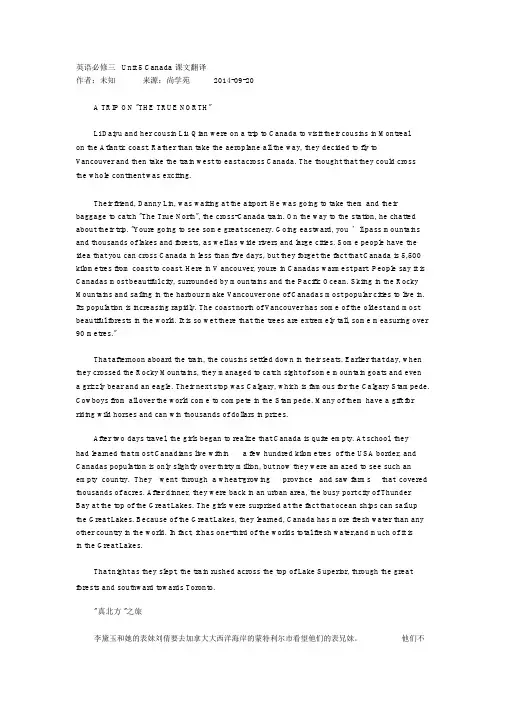
英语必修三Unit 5 Canada 课文翻译作者:未知来源:尚学苑2014-09-20A TRIP ON "THE TRUE NORTH"Li Daiyu and her cousin Liu Qian were on a trip to Canada to visit their cousins in Montrealon the Atlantic coast. Rather than take the aeroplane all the way, they decided to fly toVancouver and then take the train west to east across Canada. The thought that they could cross the whole continent was exciting.Their friend, Danny Lin, was waiting at the airport. He was going to take them and their baggage to catch "The True North", the cross-Canada train. On the way to the station, he chatted about their trip. "Youre going to see some great scenery. Going eastward, you ’ll pass mountains and thousands of lakes and forests, as well as wide rivers and large cities. Some people have the idea that you can cross Canada in less than five days, but they forget the fact that Canada is 5,500 kilometres from coast to coast. Here in V ancouver, youre in Canadas warmest part. People say it is Canadas most beautiful city, surrounded by mountains and the Pacific Ocean. Skiing in the Rocky Mountains and sailing in the harbour make Vancouver one of Canadas most popular cities to live in. Its population is increasing rapidly. The coast north of Vancouver has some of the oldest and most beautiful forests in the world. It is so wet there that the trees are extremely tall, some measuring over 90 metres."That afternoon aboard the train, the cousins settled down in their seats. Earlier that day, when they crossed the Rocky Mountains, they managed to catch sight of some mountain goats and even a grizzly bear and an eagle. Their next stop was Calgary, which is famous for the Calgary Stampede. Cowboys from all over the world come to compete in the Stampede. Many of them have a gift for riding wild horses and can win thousands of dollars in prizes.After two days travel, the girls began to realize that Canada is quite empty. At school, theyhad learned that most Canadians live within a few hundred kilometres of the USA border, and Canadas population is only slightly over thirty million, but now they were amazed to see such an empty country. They went through a wheat-growing province and saw farms that covered thousands of acres. After dinner, they were back in an urban area, the busy port city of ThunderBay at the top of the Great Lakes. The girls were surprised at the fact that ocean ships can sail up the Great Lakes. Because of the Great Lakes, they learned, Canada has more fresh water than any other country in the world. In fact, it has one-third of the worlds total fresh water,and much of it isin the Great Lakes.That night as they slept, the train rushed across the top of Lake Superior, through the great forests and southward towards Toronto."真北方 "之旅李黛玉和她的表妹刘倩要去加拿大大西洋海岸的蒙特利尔市看望他们的表兄妹。
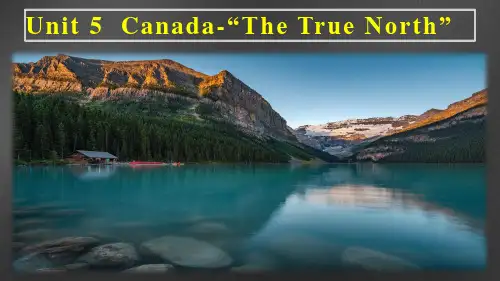
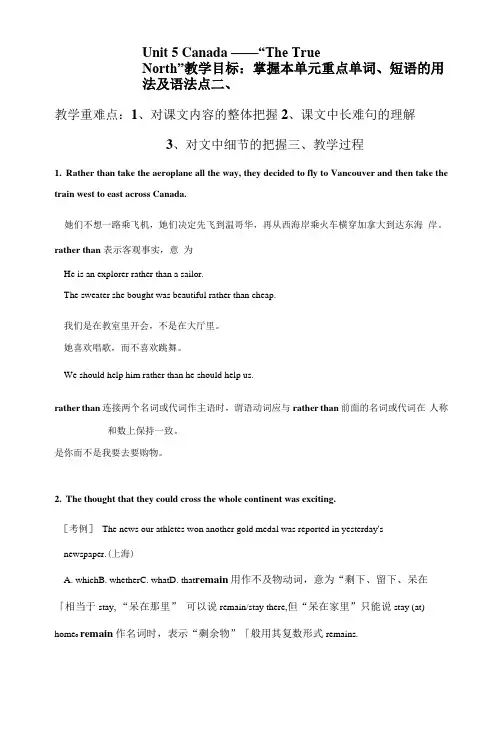
Unit 5 Canada ——“The TrueNorth”教学目标:掌握本单元重点单词、短语的用法及语法点二、教学重难点:1、对课文内容的整体把握2、课文中长难句的理解3、对文中细节的把握三、教学过程1.Rather than take the aeroplane all the way, they decided to fly to Vancouver and then take the train west to east across Canada.她们不想一路乘飞机,她们决定先飞到温哥华,再从西海岸乘火车横穿加拿大到达东海岸。
rather than 表示客观事实,意为He is an explorer rather than a sailor.The sweater she bought was beautiful rather than cheap.我们是在教室里开会,不是在大厅里。
她喜欢唱歌,而不喜欢跳舞。
We should help him rather than he should help us.rather than连接两个名词或代词作主语时,谓语动词应与rather than前面的名词或代词在人称和数上保持一致。
是你而不是我要去要购物。
2.The thought that they could cross the whole continent was exciting.[考例]The news our athletes won another gold medal was reported in yesterday's newspaper.(上海)A. whichB. whetherC. whatD. that remain用作不及物动词,意为“剩下、留下、呆在「相当于stay, “呆在那里” 可以说remain/stay there,但“呆在家里”只能说stay (at) home o remain作名词时,表示“剩余物”「般用其复数形式remains.Remain / Stay here until I come back.They remain / stay friends for many years.3.settle down舒适地坐下/躺下对(工作/生活)定下心来使……平静1)那个老人希望他儿子结婚并定居下来。
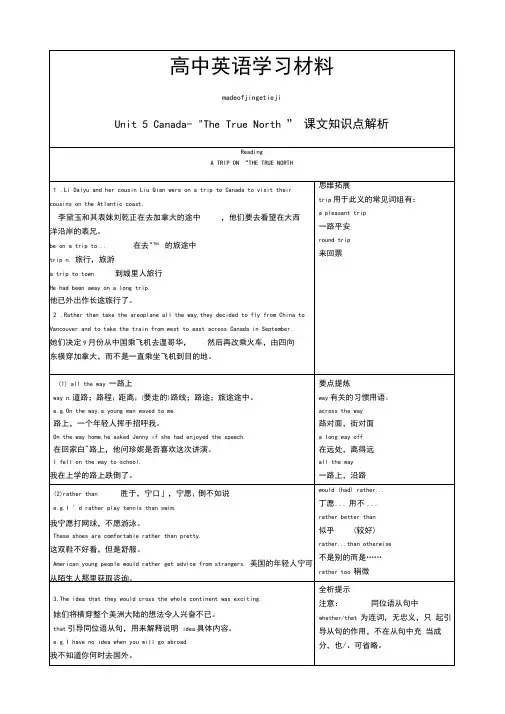
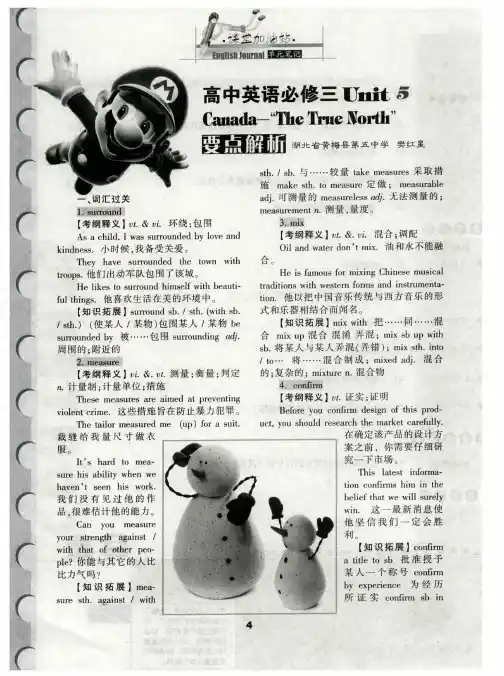
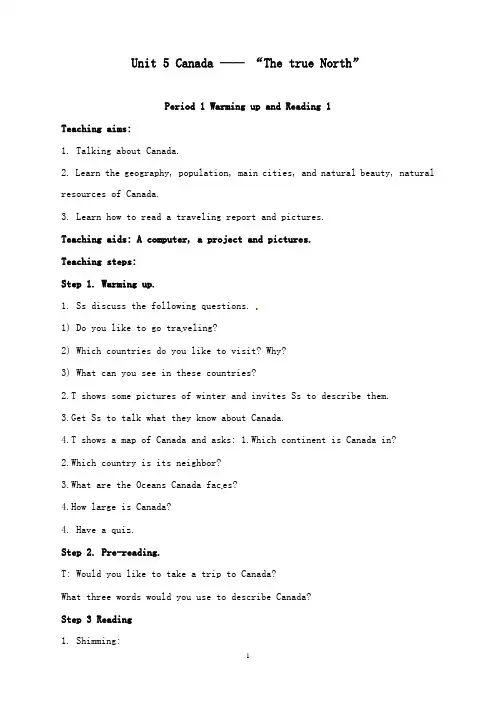
Unit 5 Canada ——“The true North”Period 1 Warming up and Reading 1Teaching aims:1. Talking about Canada.2. Learn the geography, population, main cities, and natural beauty, natural resources of Canada.3. Learn how to read a traveling report and pictures.Teaching aids: A computer, a project and pictures.Teaching steps:Step 1. Warming up.1. Ss discuss the following questions.1) Do you like to go tra veling?2) Which countries do you like to visit? Why?3) What can you see in these countries?2.T shows some pictures of winter and invites Ss to describe them.3.Get Ss to talk what they know about Canada.4.T shows a map of Canada and asks: 1.Which continent is Canada in?2.Which country is its neighbor?3.What are the Oceans Canada fac es?4.How large is Canada?4. Have a quiz.Step 2. Pre-reading.T: Would you like to take a trip to Canada?What three words would you use to describe Canada?Step 3 Reading1. Shimming:Get Ss to read the passage quickly and answer the following questions: 1) What is the passage mainly about?Sample:The passage is about a trip of two girls, and it tells us some information about Canada.2) What is “The Ture No rth”?Sample:“The True North” is the train that goes across Canada / the cross-Canada train.3) How many cities are mentioned in the text? What are they?Sample:Vancouver – Calgary—Thunder Bay—Toronto4) What do you know about each city?Vancouver :the warmest part of Canada; the most beautiful city in Canadamany Asian want to live there;the trees are extremely tall.the oldest and most beautiful forests in the worldCalgary:famous for StampedeCowboys come to compete in riding wild horses.good at working with animalsthey can win a lot of money in prizes.Thunder Bay:at the top end of the Great Lakes;very busy portclose to the centre of the country ,so that ocean ships can go there.2. Detailed reading:1) Get Ss to read the passage again and correct the following sentences.1. The girls went to Canada to see their relatives in Montreal.(in the East of Canada / on the Atlantic coast of Canada)2. Danny Lin was goi ng to drive them to Vancouver.(the train station to catch the cross-Canada train)3. You can cross Canada in less than five days by bicycle.(can’t)4. The girls looked out the windows and saw Native Indians and cowboys.(a grizzly bear, mountain goats and wild scenery)5. Thunder Bay is a port city in the south of Canada, near Toronto.(at the top end of the Great Lakes, near the center of the country)2) Listen to the tape and fill in the blanks from the text.Canada is _____ than the United States. It is the _______largest country in the world.It is _____ kilometers from coast to coast in Canada.The population of Canada is onl y slightly over_____________.Canada has _________ of the world’s fresh water, much of which is in the ___________.On the coast north of Vancouver some of the oldest and most beautiful _______ in the world still remain. It is so wet there that the trees are extremely ______.Period 2 Language points:1.Canada is a multicultural country like China. 加拿大像中国一样是一个多元化国家。
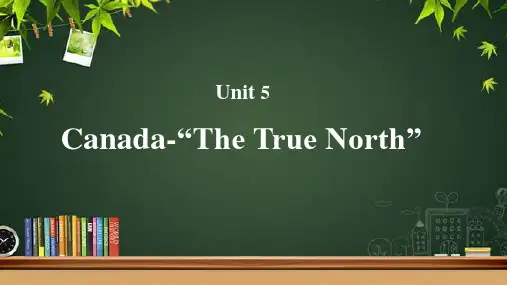
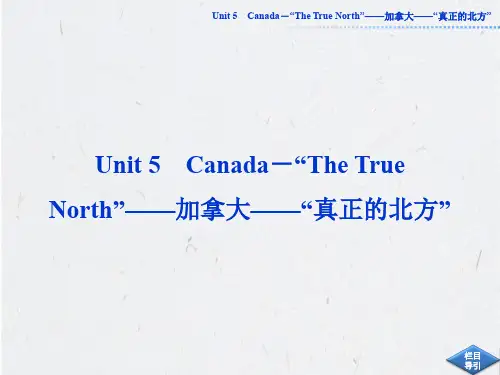
人教版高中英语必修3教案Unit 5 Canada ----- “The True North”The unit introduces the students to some basic information about Canada, its geography, its culture and its population. Canada is a big country. It is the second largest country in the world after Russia. It is also a beautiful country, especially in Autumn, you can see maple leaves in hundreds of different colors. Canada is a multicultural country as well, with citizens from European, Asian and African countries.The unit is essentially descriptive, although some questions can be introduced about different cultures.The functional items dealing with direction and locations can be easily applied to descriptions of China and other world geography.Four lakes: Lake superior (苏必利尔湖), Lake Huron(休伦湖), Lake Erie(伊利湖) and Lake Ontario(安大略湖).Total area: about 9,984,670 square kilometersPopulation: about 32,227,000, very sparsely populated countryLanguages: English 59.3% (official), French 23.2% (official), other 17.5%Administrative divisions: 10 provinces and 3 territoriesSports: Canada`s most popular sports include swimming, ice hockey, cross-country and Alpine skiing, baseball, tennis, basketball and golf. Ice hockey and lacrosse are Canada`s national sports.The national emblems(标志, 徽章) of Canada: There are two national emblems of Canada. One is the Canadian beaver, a clever and hardworking animal that has thick fur and a wide flat tail. It cuts down trees with its teeth. The second emblem is the Canadian maple leaf that is in the middle of the national flag which is considered an official symbol of Canada. The best time to see the leaves is autumn when the maple leaves turn hundreds of different colors. As the saying goes, “If you have never seen Canada in the fall, you have never known the meaning of brightly colored.”Niagara Falls: It is said that “if you haven`t been to Niagara Falls, you cannot be said to have been to Canada”. Three reasons make Niagara Falls exceed all the other falls in the world: First of all, it has a very long history as a tourist attraction. Secondly, it provides a unique sight to tourists. Thirdly, being situated on the Canadian-US border, it is very easy for tourists to get there. As a lot of young couples come here to celebrate their honeymoon, it is known as “the honeymoon capital of the world”.The first period: Warming up and ReadingImportant points: let the students read the passage and learn about the geography, population, main cities, natural beauty, and natural resources of Canada. Get t students to learn different reading skills.Difficult points: develop students` reading ability and enable them to learn about some basic information and talk about Canada.The passage describes a trip across Canada by train. The name of the train “the True North” is taken from a line in Cana`s national anthem.Step 1 Leading-in and Warming up1. Show them a map of Canada and talk about Canada. Then ask them some questions:1). What kind of country is Canada?(Canada is a multicultural country.)2). How large is it?(It is the second largest country in the world. It covers an area of 9.984.670 square kilometers. It is a bit bigger than China.)3). What else do you know about Canada?(vary answers.)Step 2 Pre-reading1. Let students discuss the following questions:1). What is the longest trip you have ever taken?2). If you take a trip to Canada, what do you think you might see there?3). What three words would you use to describe Canada?2. Have students turn to Page 34 and look at the title of the reading passage and the pictures and predict what the passage is about. Then have the students read the passage quickly to see if they are right.Step 3 ReadingFast reading: read the passage and answer the following questions.1). What is the passage about?(It is about a trip of two girls, and it tells us some information about Canada.)2). What is “The True North”?(It is the train that goes across Canada / the cross-Canada train.)3). How many cities are mentioned in the text? What are they?(Five. They are Montreal, Vancouver, Calgary, Thunder Bay and Toronto.)2. Intensive reading: read the text carefully to understand the main idea of each paragraph and important details.Choose the best answers to each question.1). As you go eastwards, you can see the following things except------.A. mountainsB. thousands of lakesC. forests and wide riversD. cows2). Who will take part in the Calgary Stampede?A. Cowboys from StampedeB. people from CanadaC. Anyone who has a gift for ridingD. Cowboys from all over the world3). Which of the following statement is true?A. One can cross Canada in less than 5 day by trainB. Many people think Calgary is the most beautiful city in CanadaC. In fact, the population of Canada is more than thirty millionD. Ocean ships cannot reach Thunder Bay4). Which of the following shows the right route of the cousin`s travel?A. Toronto →Calgary →Vancouver →Thunder BayB. Vancouver →Calgary→Thunder Bay →TorontoC. Vancouver →Thunder Bay →Calgary →TorontoD. Toronto →Thunder Bay →Calgary →Vancouver(The answers: DDCB)4. Answer the following questions.1). What continent are the cousins crossing?(They are crossing The North America.)2). Why are they not flying directly to the Atlantic coast?(They want to take the train from west to east across Canada.)3). Why is the population of Vancouver growing so rapidly?(It is beautiful with mountains and oceans surrounding.)4). What happens at the Calgary Stampede?(Cowboys compete in riding wild horses for thousands of dollars.)5). How are ocean ships able to reach the center of Canada?(They can follow the St Lawrence River and the Great Lakes.)6). What are some of Canada`s greatest natural resources?(Canada has fresh water from its lakes and rivers and wood from its forests.)5. Reading and discussing: read the passage a third time and then discuss these questions.1) Which part of the reading passage interests you most?(I am most interested in the part about Calgary. I hope to visit it someday and see the Calgary stampede. I love animals, and I think it will be very interesting to see cowboys who have a gift for riding wild horses.)2) If someday you go to Canada, where will you go? Why?6. Dealing some language points:Help them analyze some difficult, long and complex sentences and guess the meaning of some new words and expressions. Encourage them to try to deal with the language points in the context. Give them some explanation if necessary.7. Listening and reading aloud:Ask them to read the passage aloud to the tape and let them pay attention to the pronunciation of each new words and the pause within each sentence.Tell them to pick out the useful collocations: be on a trip to, rather than, take the aeroplane, all the way, take the train, on the way to, chat about, as well as, less than, aboard the train, settle down, manage to do, catch sight of, be famous for, have a gift for, thousands of, in prizes, be amazed to do, at the top of, be surprised at, because of, fresh waterStep 4 Consolidation2. Complete the summary of the story with one word in each blank and retell the whole story.Li Daiyu and Liu Qian were on a trip across Canada. Instead of taking the aeroplane all the way, they would cross the whole continent of Canada in a train after arriving Vancouver by air.Danny Lin waited for them at the airport and gave them a brief introduction about Canada, the second biggest country in the world and Vancouver, the most beautiful city of the country, while taking them to catch the train, “The True North”.Having settled down in the seats, they looked out of the window at the wild scenery, the mountain goats, and grizzly bears. They went by the city of Calgary and arrived in Thunder Bay, a city at the top of the Great Lakes, learning more about Canada of its population resources and so on. Their last stop was Toronto, one of the southernmost cities in Canada.Step 5 HomeworkLearn the useful new words and expressions by heart.Read the reading passage again try to retell the passage.The second period: Learning about language: important language pointsThe emphasis of this period will be place on the important new words, expressions and sentence patterns in the parts Warming up, Reading, and Comprehending.Important points: enable students to grasp the usages of such important new words and expressions as surround, measure, confirm, impress, rather than, manage to do, and to master the patterns “The thought that they could cross the whole continent was exciting.” And “It is so wet there that the trees are extremely tall, some measuring over 90 meters”Difficult points: how to get students to understand some useful words and expressions as well as some long and difficult sentences correctly.Knowledge aims:1). Get students to learn and grasp the important useful new words and expressions in this part.2). Let students learn the following important useful sentence patterns:Rather than take the aeroplane all the way, they decided to fly to Vancouver and then take the train west to east across Canada. (rather than …..)The thought that they could cross the whole continent was exciting. (noun clause as the appositive)Going eastward, you will pass mountains and thousands of lakes and forests, as well as wide rivers and large cities. (present participle used as adverbial)Skiing in the Rocky Mountains and sailing in the harbor make Vancouver one of Canada`s most popular cities to live in. (make + O + O.C)It is so wet there that the trees are extremely tall, some measuring over 90 meters. (“pronoun + doing” used as adverbial)Because of the Great Lakes, they learned, Canada has more fresh water than any other country in the world. (more… than any other….)Step 1 RevisionCheck the homework exercises.Ask some students to retell the passage A TRIP ON “THE TRUE NORTH”.Step 2 Reading and findingGet students to read through Warming up, Pre-reading, Reading and Comprehending to underline all the new words and expressions or collocations.Step 3 Practice for useful words and expressions.Turn to page 36. go through the exercises in Discovering useful new words and expressions with students and make sure they know what to do.Step 4 Studying important language points1. multi- : multiparty多党的, multinational多民族的, multipurpose多用途的, multiform多形式的, multistory多层的, multimedia多媒体的a multicultural country多元文化国家2. be on a trip to…., go on a trip to…., make a trip to….., take a trip to….3. rather than: in preference to sb. / sth.I will have a lemonade rather than a coke.He was busy writing a letter rather than reading a newspaper.4. surround: cause sb. / sth. to move into position all round sb. / sthsurround sb. / sth. with sb. / sth; be surrounded with…..The fence surrounds the school.They have surrounded the town with troops.The house is surrounded by high walls.5. north of = to the north ofThey lives (to the) east of Los Angeles.It`s about four hundred kilometers northeast of Toronto.6. measure: find the size, length, volume, etc. by comparing it with a standard unit, asses, 估计, 衡量, 判定Mother measured me to see what size of dress I should have.It is hard to measure his ability when we haven`t seen his work.The room measures 10 meters across.Which measure do they use?They took strong measures against dangerous drivers.7. settle down: cause sb. to become calm, less restlessWait until the children settled down before you start the lesson.Have you settled down in your new job yet?8. manage to do sth. succeed in doing sth.The pilot managed to circle the balloon for some time.At first, no ready technical data were available, but we managed to go without.I just about managed to get up the stairs.9. catch sight of: see sb. / sth. for momentShe caught sight of a car in the distance.10. have a gift for: have natural talent or ability in sth. / doing sth.It seems he has a gift for learning language.She has a gift for music.Step 5 Using words, expressions and patternsDo exercises in Using words and expressions on page 70-71.Step 6 HomeworkFinish off the Workbook exercises.Learn the new words and expressions by heart.设计方案(二)Step 1 Revision1. Check the homework.2. Ask some students to dictate some useful new words and expressions.Step 2 V ocabulary study1. Let students review the new words and expressions in Warming up, Pre-reading, Reading and Comprehending and give time to students to ask their own questions.2. Explain the new words and expressions.Step 3 Practice for useful words and expressionsLet students do the following exercises and check the answers after most of them finish.1.Find words that mean the same to fill in the blanks.1). ------ bags that people take with them when they travel2). ------ a government member who is in charge of a government department3). ------ a short informal test4). ------ to take to someone in a friendly, informal way5). ------ on or onto a ship, plane, bus or train6). ------ general appearance of nature around you, especially beautiful nature7). ------ in or by a very small amount, so small that it almost cannot be seen8). ------ to be all around somebody or something on every side3. Make sentences with the useful expressions below.rather than, settle down, manage to do, catch sight of, have a gift forStep 4 Sentence focusAsk students to read through the Warming up and Reading to find out the difficult sentences they cannot understand and give time to students to ask their own questions. Explain them to the class.Step 5 Workbook exercises for consolidationAsk students to do the exercises in Using Words and Expressions on page 70-71 to consolidation what they have learned in this period.Step 6 HomeworkLearn the new words and expressions by heart.Finish off the Workbook exercises.Do exercise 3 on page 70-71 in the exercise book.Surf the Internet to find as much information about Canada as you can. Take notes and compare it withThe third period: Learning about language: GrammarThe teaching period mainly deals with the following: 1). Reviewing noun clauses as the subject; 2). Learning the new grammar item: noun clauses as the appositive.Important points: get the students to understand and use noun clauses as the appositive.Difficult points: enable students to learn how to use noun clauses as the appositive correctly.Step 1 Revision1. Check the homework exercises.2. Dictate some new words and expressions.3. Underline the noun clauses in each sentence of the following and then tell what kind of noun clause it is. What it was to become was a mystery.I don`t know who will help Henry to win the bet.His trouble is that he doesn`t know anyone in London.It has not been decided yet when the new restaurant will open.It looked as if it was going to snow.Do you know why he crossed his arms?Step 2 PreparationShow the following two sentences for them to see. Ask them to read each of them and then underline its appositive.Their friend, Danny Lin, was waiting at the airport.He was going to take them and their baggage to catch “The True North”, the cross-Canada train.The thought that they could cross the whole continent was exciting.We were very excited at the news that our team had won.Step 3 Grammar learning1. Reading and learning: turn to page 34 to read through the reading passage and find out all the sentences where noun clauses are used as the oppositive and underline them.The thought that they could cross the whole continent was exciting.Some people have the idea that you can cross Canada in less than five days, but they forget the fact that Canada is 5,500 kilometers from coast to coast.The girls were surprised at the fact that ocean ships can sail up the Great Lakes.2.Summing up: noun clauses as the appositive.同位语从句在主从复合句中, 用作同谓语的从句, 叫同位语从句. 它一般跟在某些名词( 如fact, news, truth, hop, problem, information, wish, promise, evidence, report, explanation, suggestion, conclusion) 等后, 用以说明或者解释前面的名词.连接词:A. 从属连词: that, whether等.The news that they had won the game soon spread over the whole city.We will discuss the problem whether the sports meeting will be held on time.B. 连接代词: what, who等.Next comes the question what you want to put in the box.I have no idea who he is.C. 连接副词: how, when, why等.I have no impression how he came back, perhaps by bike.I have no idea when he will be back.同位语从句与定语从句的区别:从形式上看, 同位语从句和定语从句很相似, 都是放在某一个名词后面, 但同位语从句不同于定语从句. 同位语从句对名词加以补充说明, 是名词全部内容的体现; 定语从句说明先行词的性质与特征, 与先行词是修饰与被修饰的关系.The news that our team has won is true. (同位语从句)The news that you heard is not true. (定语从句)That 在同位语中不作任何成分, 是从属连词; 而在定语从句中但任句子成分, 是关系代词.The fact that we succeeded pleased everybody.The fact that we talked about is very interesting.Step 4 Grammar practiceTurn to page 37 and do Exercise 2 in Discovering useful structures.Turn to page 71 and do Exercise 1.Step 5 Closing by a quiz.1). They have no idea at all -----.A. where he has goneB. where did he goC. which place has he goneD. where has he gone2). I have no idea ----- far the airport is from here.A. whatB. howC. it`sD. that3). The manager asked the question ----- I would like to be his secretary.A. ifB. thatC. whetherD. how4). ----- is a fact ----- English is being accepted as an international language.A. It; thatB. That; thatC. It; whichD. As; that5). The reason ----- she didn`t say anything was ----- she was ill.A. why; thatB. why; becauseC. that; whyD. why; why6). There is a new problem involved in the popularity of private cars -----road conditions need to be improved.A. thatB. whichC. whereD. when7). The question has been raised at the meeting ----- each member country should share the expenses of the committee. A. which B. if C. what D. whether8). There is a common belief among them ----- rubbish can and should be put to good use.A. whichB. ifC. whetherD. that9). Information has been put forward ----- more middle school graduates will be admitted into university.A. whileB. thatC. whenD. as10). It is no longer a question ----- man is learning more and more about space.A. whetherB. thatC. ifD. how11). Several years ago no one had any idea ___ Xiao Shenyang could become so popular all round the country.A. whetherB. whatC. thatD. when12). Most students who learn English will meet with a problem ____ they can remember so many English words. A. when B. where C. that D. how13). There is feeling in him ____ he will make much money after this project.A. whichB. whatC. thatD. how14). The man looked so familiar, but I didn`t have any idea ____ I had met him before.A. whichB. howC. thatD. where15). There is no doubt _____ we can defeat A/H1N1 finally.A. whetherB. thatC. whatD. if16). MR Green asked the boy a question _____ he could guide him to the headmaster`s office.A. whetherB. thatC. whatD. if17). The view ____ Dr Smith raised at the meeting was paid much attention to.A. howB. whatC. whichD. why18). Gordon asks me the question whenever he meets me _____ the work ____ he has been doing for several years is worth doing.A. that; thatB. when; whichC. where; whatD. whether; 不填19). It was a matter of _____ would take the position after Bob`s retirement.A. whoB. whoeverC. whomD. whomever20). Lucy explained to her doctor _____ her headache had begun one year before, and ______, only because of this, she had failed the exam.A. when; howB. how; howC. how; whenD. why; why( Answers: ABCAA ADDBB CDCDB ACDAB)Step 6 HomeworkFinish off the Workbook exercises.Preview the reading passage “The True North” FROM TORANTO TO MONTRAL on page 38.The forth period: Using Language: Listening and talkingThe listening passage introduces information about the cultural and racial composition of Canada. Canada is one of the few countries that have an official multicultural policy. The population is changing rapidly and immigrants from China are among the most numerous recently.Important points: develop students` listening ability and enable them to master different listening skills in order to get them to talk about the major similarities and differences between China and Canada.Difficult points: get students to listen to the materials and talk about the similarities and differences between Canada and China.Step 1 Revision1. Check the homework exercises.2. Ask some students to translate some sentences using noun clauses as the appositive.1). 他登上月球的消息迅速传遍了全国.2). 将军下达了战士们立即过河的命令.3). 是否该做这件事,这一问题使他很烦恼.4). 你不知道我有多么着急.5). 他突然想到敌人可能已经逃出城了.Step 2 Warming up1. Tell students to turn to Page 37. and listen to the material after having discussed the main idea.2. Play the tape for them to listen and do the exercises according to the information.1). Canada is a mixture of ----------------------.2). Canada encourages people to keep ------------------.3). If you live in the province of Quebec, ------------------------.4). Native Indians and Inuit are trying to -------------------------.5). More than ------------ languages are used in radio and TV programs.6). You may find areas where ----------- live near each other.7). The families --------------- are usually all mixed up.Step 3 Listening on Page 691. Turn to Page 69. First, ask them to read through the directions and the exercises to make sure they know what to do. Then, get them to do some exercises.2. Play the tape for them to listen two times.True or false exercises:1). China is over 7000 kilometers from east to west.2). Both China and Canada have mountains in the west of the country.3). The Great Wall cannot keep the desert`s dust away from Beijing.4). China has 15 neighboring countries while Canada only has one.5). Canadians cannot talk with people in their neighboring country because they do not speak English.Step 4 TalkingShow them a map of Canada and a map of China and get them to talk about the similarities and differences between Canada and China.Step 5 Listening Task on Page 721. Turn to page 72 and tell students: we are going to listen to the introductions of three famous Canadians in different areas of work.Step 6 SummaryWe mainly focus on the listening ability. It is very important. If your listening is poor, you had better practice more. The more you listen to English, the better your listening is. Remember: Practice makes perfect.Step 7 HomeworkFinish off the homework.Read the listening texts again and try to learn more about Canada from them.The fifth period: Extensive readingIn this period, the teaching emphasis will be put on developing students` reading ability by reading extensively.Important points: develop students` reading skills by extensive reading.Difficult points: get students to understand some difficult and long sentences by using reading strategies such as skimming and scanning.Step 1 RevisionCheck the homework exercises.Ask some students to talk about the major similarities and differences between China and Canada.Step 2 Leading-inHave some students to retell the reading passage A TRIP ON “THE TRUE NORTH”.Turn to page 38 to read another passage “THE TRUE NORTH” FROM TORONTO TO MONTREAL and learn more about Canada.Step 3 Reading1. Ask students to read the passage quickly and then do the following as soon as possible.1). Tick out the things mentioned in the text.(1) the climate in Canada(2) the population in Toronto(3) the CN Tower in Toronto(4) Toronto`s economic(5) a lake which is on the north side of Niagara Falls(6) good Cantonese food(7) famous restaurants in Toronto(8) the old Montreal(9) the location of Montreal(10) brief introduction to MontrealThe answers: (1) (3) (5) (6) (8) (10)2. How many parts can the passage be divided into? Write out the main idea of each part.Part one (paragraph 1): Fall had arrived in Canada.Part two (paragraph 2-4): Their tour of the city Toronto.Part three (paragraph 5): Their travel in Montreal.Part four (paragraph6): They left for the east coast.3.Ask students to read carefully and do the following questions:1). What can sometimes be seen from the CN Tower in Toronto?(Sometimes the misty cloud that rises from Niagara Falls can be seen from the CN Tower.)2). Why is there good Cantonese food in Toronto?(There is good Cantonese food in Toronto because most of the Chinese people there came from South China, especially Hong Kong.)3). Which direction is the train going from Toronto?(The train is going east from Toronto.)4). What are the three things that show Montreal a French city?(Good coffee, good bread and good music show that Montreal is a French city.)5. Ask students to read the passage again and find out the useful collocations: from…to…, the next morning, on the ground, around noon, leave for, go on a tour, in the distance, on the south side of, on one`s way, home of, a telephone booth, around dusk, over dinner, chat with sb. come from, South China, go as far as, at dawn, be close to, spend…..doing, be on a train trip, dream ofStep 4 Important language points1. confirm: provide evidence for the truth or correctness of; establish the truth of; make definite or establish more firmly批准, 肯定证实Please confirm your telephone message by writing to me.My employer will confirm that I was there on time.The new minister will be confirmed in office by the Queen.2. not….untilWe do not leave until this evening.The noise in the street didn`t stop until midnight.3. go on a tour: visit; go on a tripWe went on a tour of the museum the other day.5.in the distance: far away 在远处The man standing in the distance is my head master.6.as far as: to the place mentioned, but no furtherI walked as far as the foot of the mountain.Sarah has read as far as the fourth volume.7.broad:a broad street, avenue, river, canal.A river twenty meters boardThere is broad support for the government`s policies.A man of broad views 心胸豁达的人Step 5 Reading TaskStep 6 HomeworkFinish off the Homework exercises.Learn the useful new words and expressions by heart.Tell your friends or family something about Canada.The sixth period: Using language: Speaking and writingImportant points: develop students` speaking and writing ability and get them to use the expressions of direction and position.Difficult points: how to develop students` speaking and writing abilities.Step 1 RevisionCheck the homework exercises.Ask some students to retell the passage “THE TRUE NORTH” FROM TORONTO TO MONTREAL.Step 2 Warming up2. Ask students to ask and answer questions in pairs by using the useful expressions.Step 3 SpeakingShow them some adjectives to express one`s feeling: excited, afraid, terrified, worried, pleased, tired, happy, impressed, surprised, amazed, satisfied …..Get them to make a dialogue to talk about two or three more impressive things and their feelings when they experienced something.Step 4 WritingTask: write a short passage about the two or three most impressive things during the trip across Canada.Step 5 HomeworkReview the contents of the unit and note down the important words and expressions.Write a short report.补充练习1. Word spelling.1). They came from Canada, so they are Canadians.(加拿大人)2). The new minister(部长) will be confirmed(批准) in office by the Queen.3). This world we live in is divided into seven continents.(大陆)4). The scenery(风景,景色) in the mountains is very beautiful.5). She has always been surrounded(包围, 环绕) with fashionable friends.6). They took strong measures(措施) against dangerous drivers.7). We reached the harbor at sunset.(港口)8). It is a tradition that the young look after the old in the family.(传统)9). The animals were terrified by the storm.(吓坏)10). His words are strongly impressed on my memory.(使印象深刻)2. Fill in the blanks with the expressions give below. Use each expression only once and make changes where1). I cold see the faint gleam of light in the distance.2). After retirement, the old man settled down in a faraway village.3). He has a gift for making everyone around him feel happy.4). Rather than risk breaking up his marriage he told his wife everything.5). She caught sight of a car in the distance and ran towards it.6). The pilot managed to circle the balloon for some time.3. Choose the best answers:1). Information has been put forward ----- more middle school graduates will be admitted into universities.A. whileB. thatC. whenD. as2). ------ is no possibility ----- Bob can win the first prize in the match.A. There; thatB. It; thatC. There; whetherD. It; whether3). There is much chance ----- Bill will recover from his injury in time for the race.A. thatB. whichC. untilD. if4). Nobody believe his reason for being absent from the class was ----- he had to meet his uncle in the airport.。
必修三Unit 5 Canada —“The True North”单元要点预览(旨在让同学整体了解本单元要点)语言要点(模块)Ⅰ.词语辨析(旨在提供完形填空所需材料)Ⅱ.词性变化(旨在提供语法填空所需材料)Ⅲ.重点词汇(旨在提供词汇综合运用材料)1. chat vi.&n. 聊天;闲聊[典例]1). What were you chatting to him about? 你和他聊了些什麽?2). I had a long chat with her (about her job).(关於她的工作)我和她聊了很久。
[重点用法]chat to/with sb (about sth) = have a chat with sb (about sth) 与某人聊天、闲谈……[练习] 根据句子的意思在括号里填入所给词的适当形式或介词。
1). She often spends hours on the phone _______ (chat) to her friends.2). We had a nice chat _______ (介词) a cup of tea.答案:1). chatting 2). over2. eastward adv. 向东adj. 向东的;朝东的[典例]1). They were traveling eastward(s) to the city which appeared in their dreams. 他们朝着东边向梦想中的城市进发。
2). The plane flied in an eastward direction. 飞机向东边飞去。
[词语归纳]eastward(s) adj./adv. 向东的,向东地westward(s) adj./adv. 向西的,向西地southward(s) adj./adv. 向南的,向南地northward(s) adj./adv. 向北的,向北地southeastward(s) adj./adv. 向东南的,向东南地northeastward(s) adj./adv. 向东北的,向东北地southwestward(s) adj./adv. 向西南的,向西南地northwestward(s) adj./adv. 向东北的,向东北地[练习] 根据句子的意思在括号里填入适当的词。